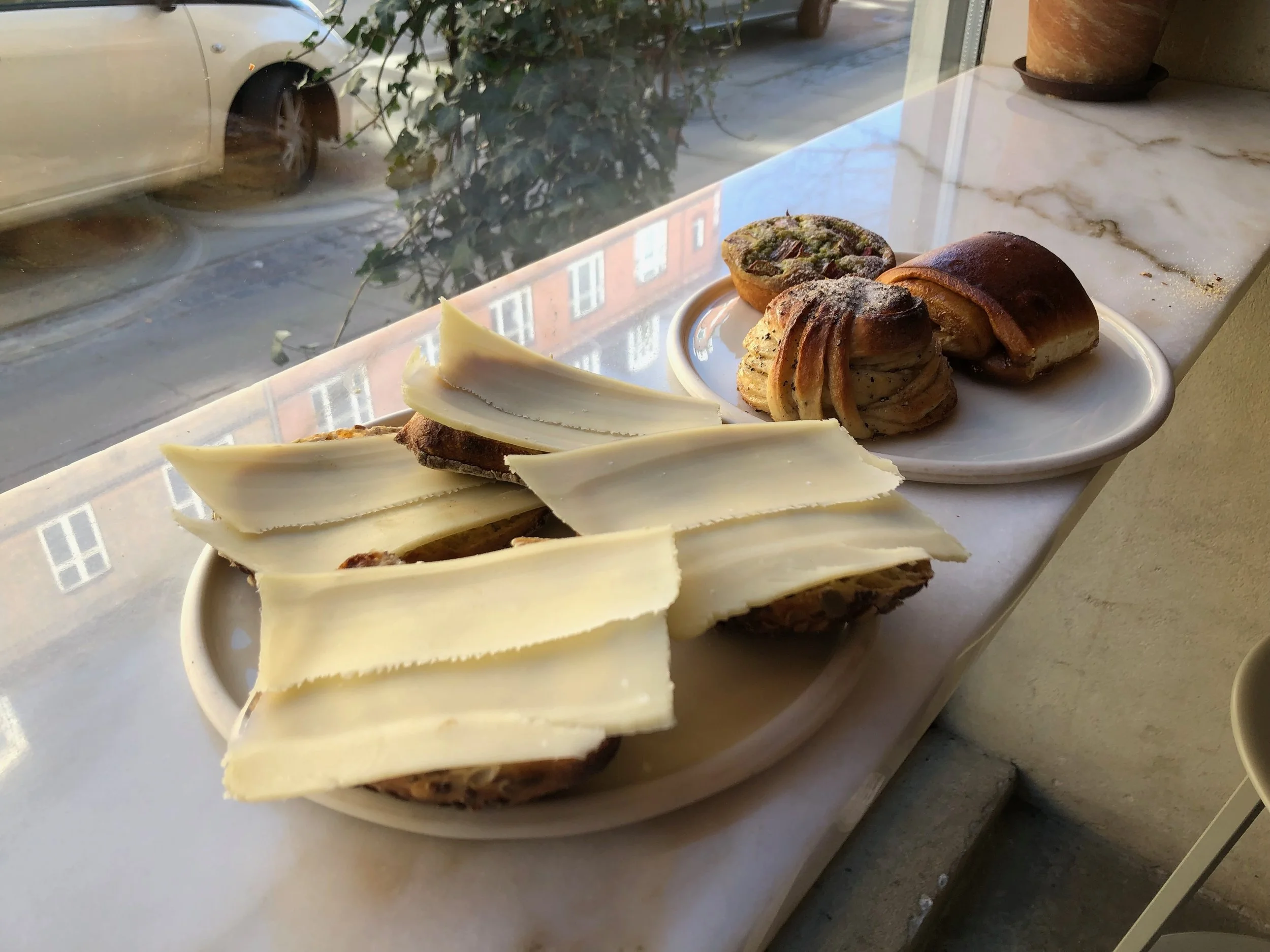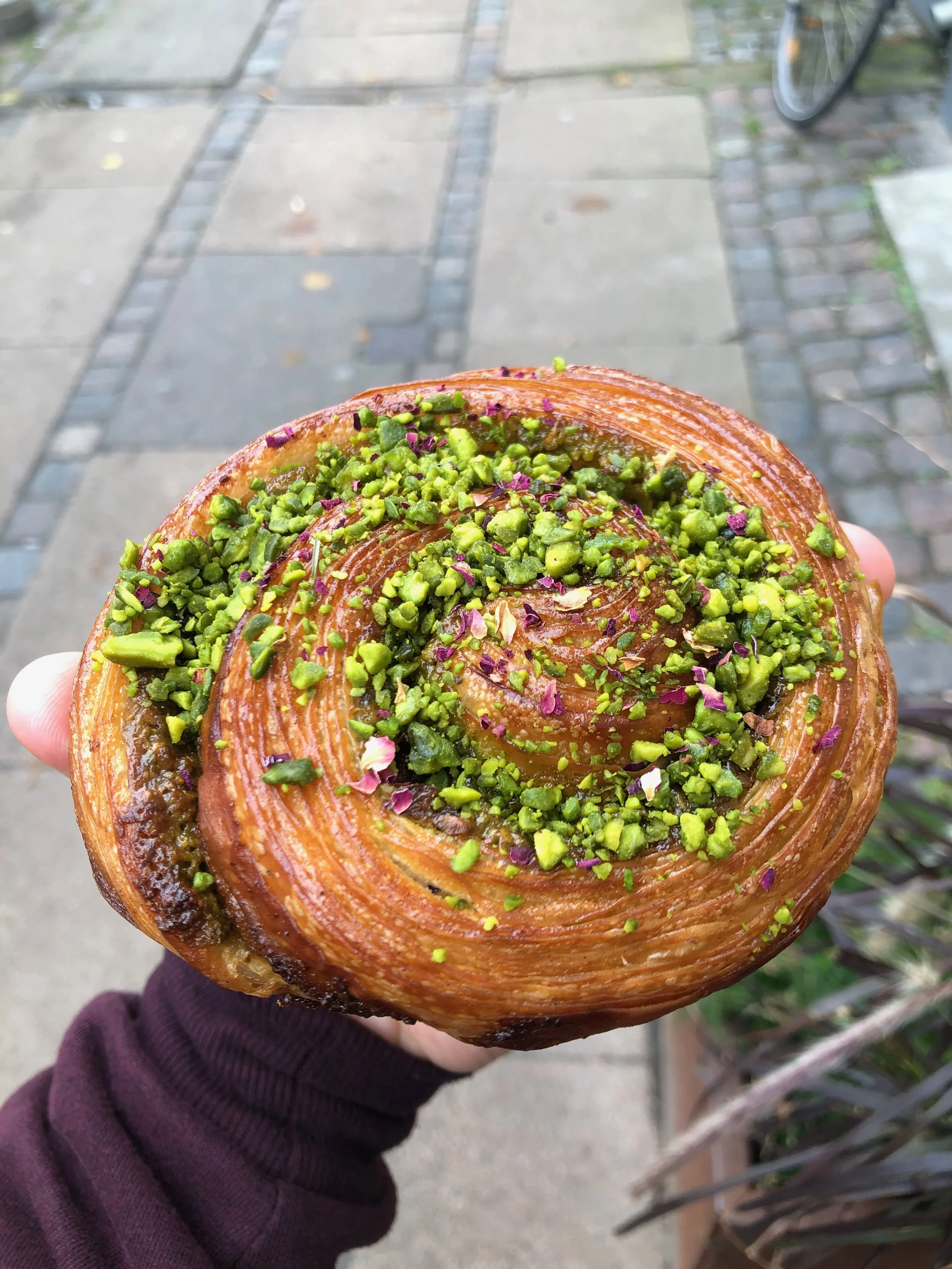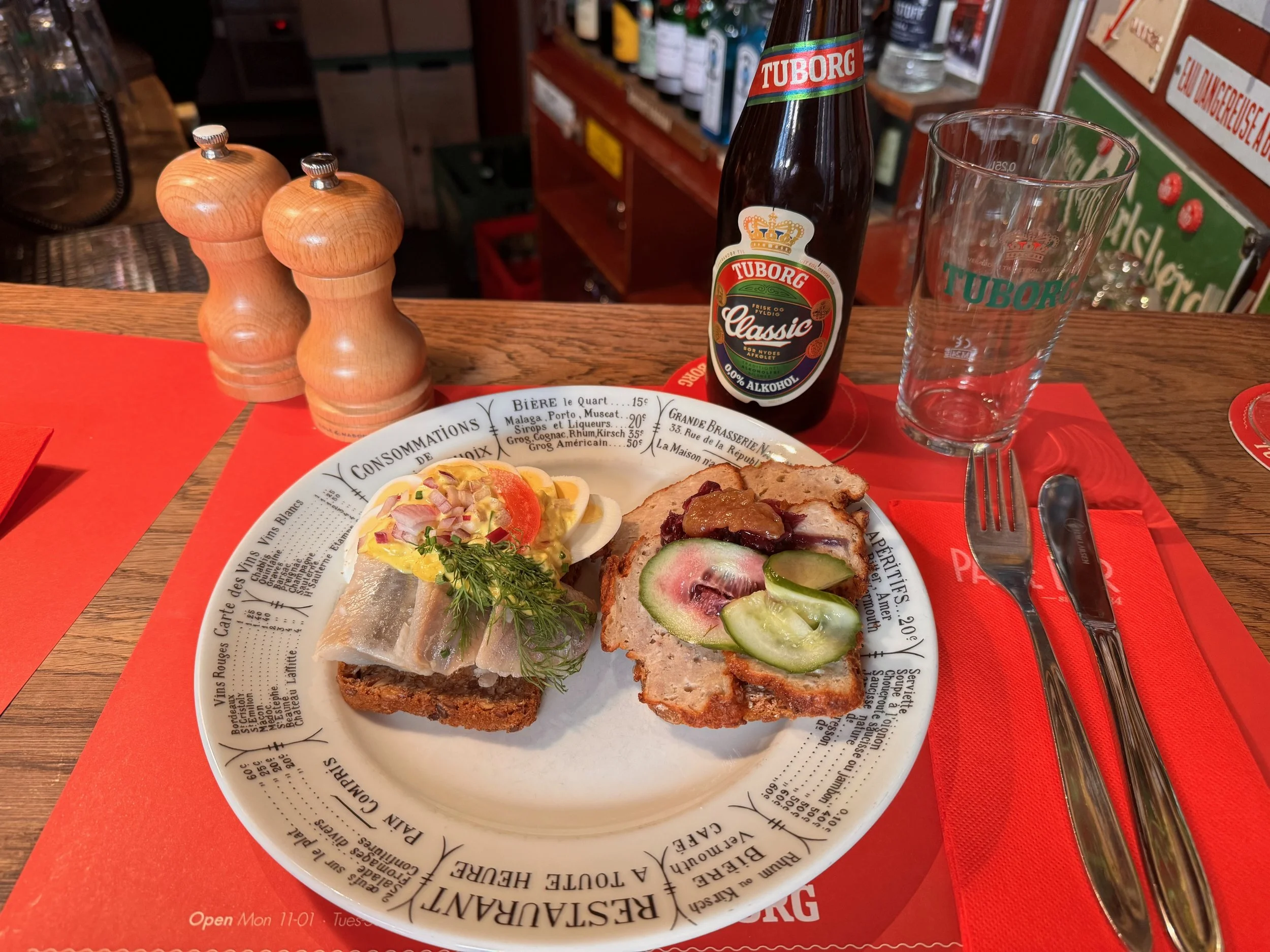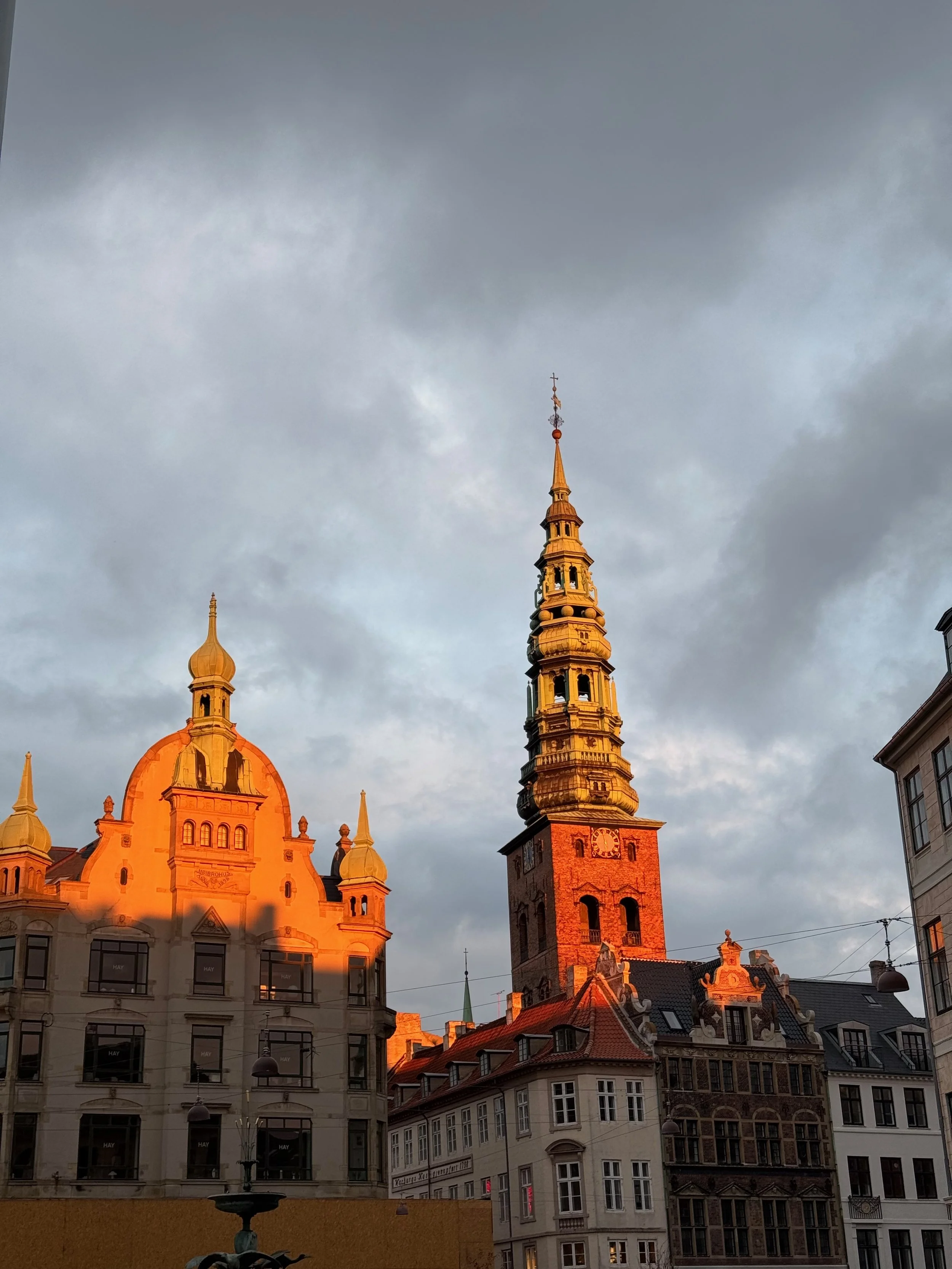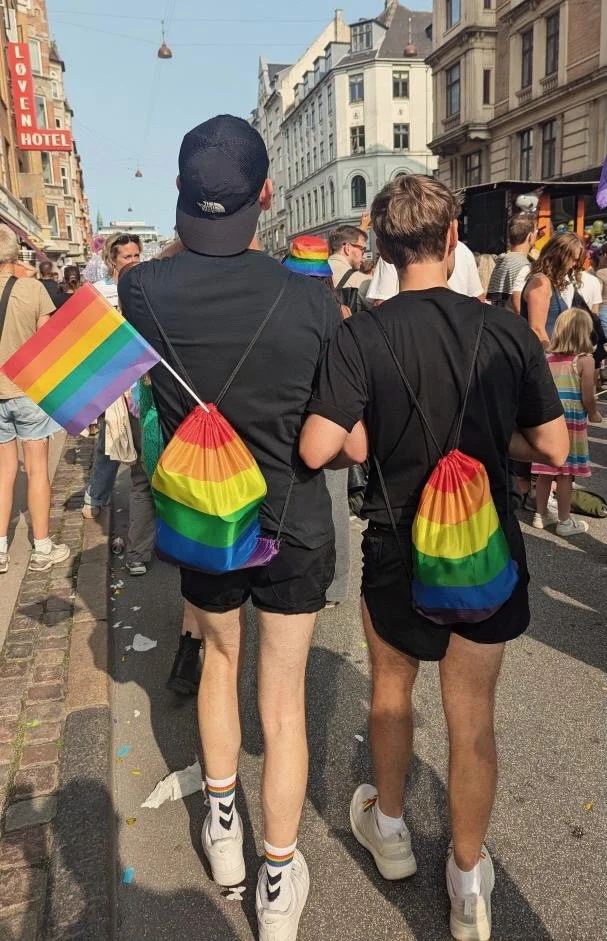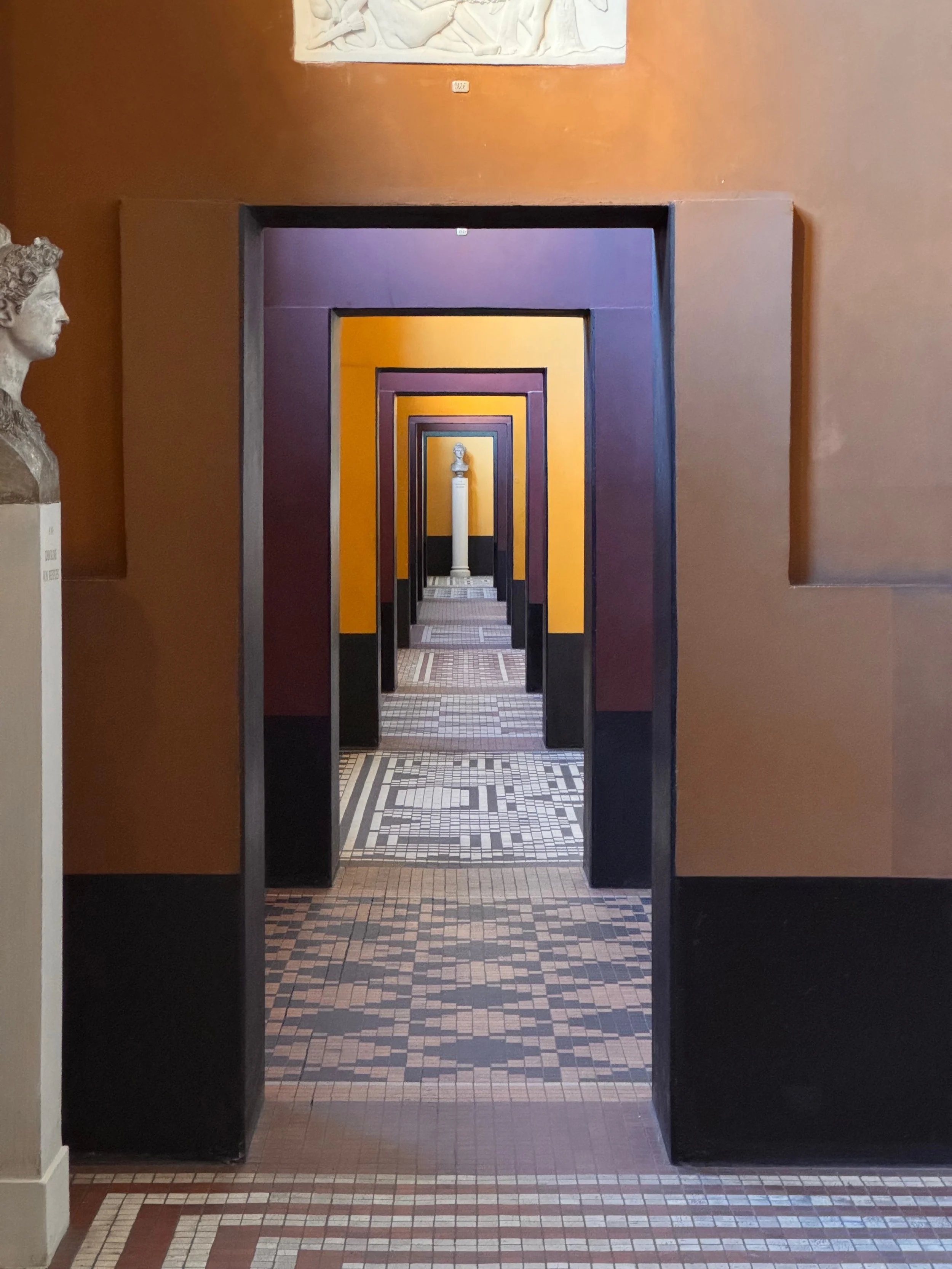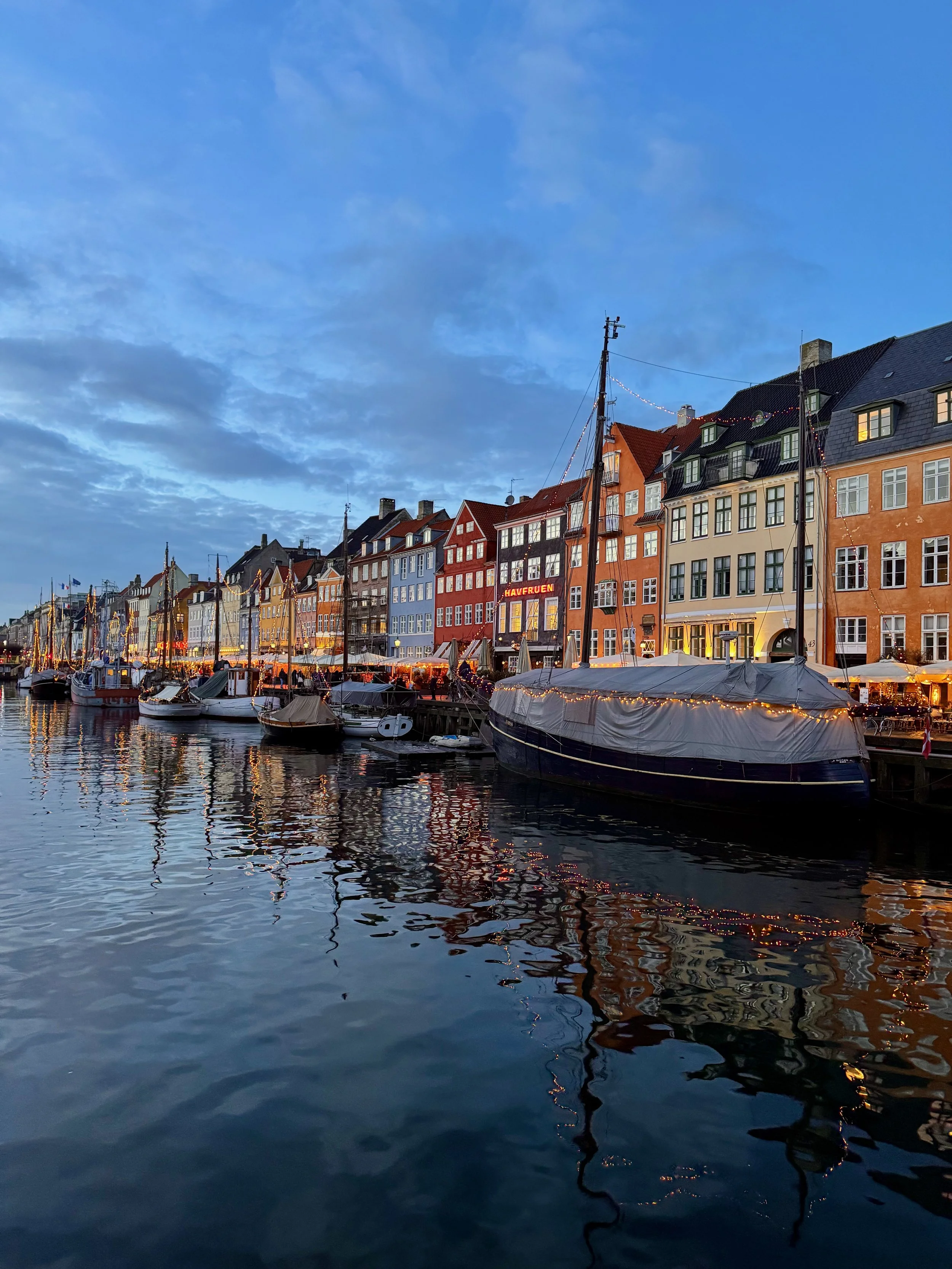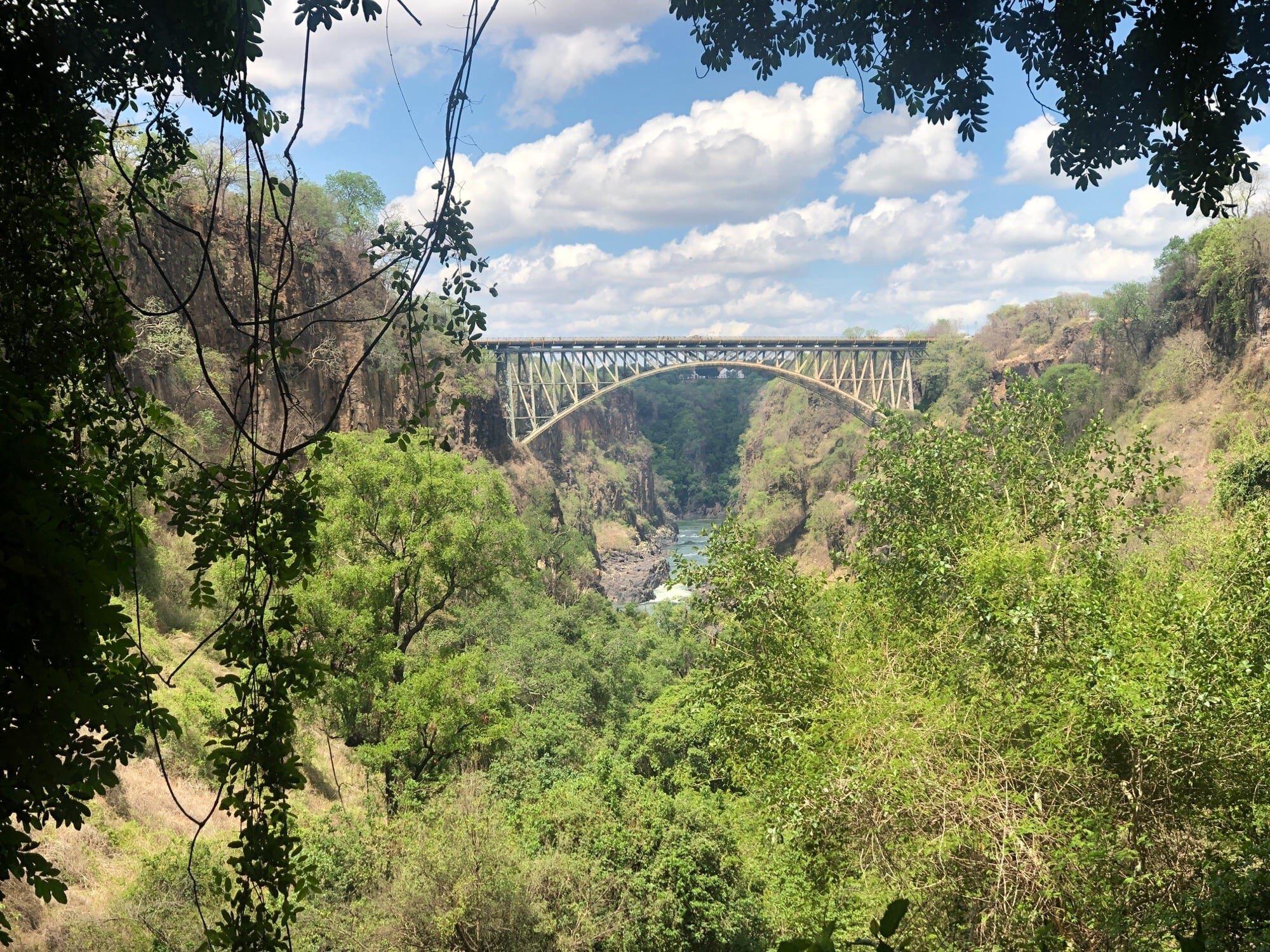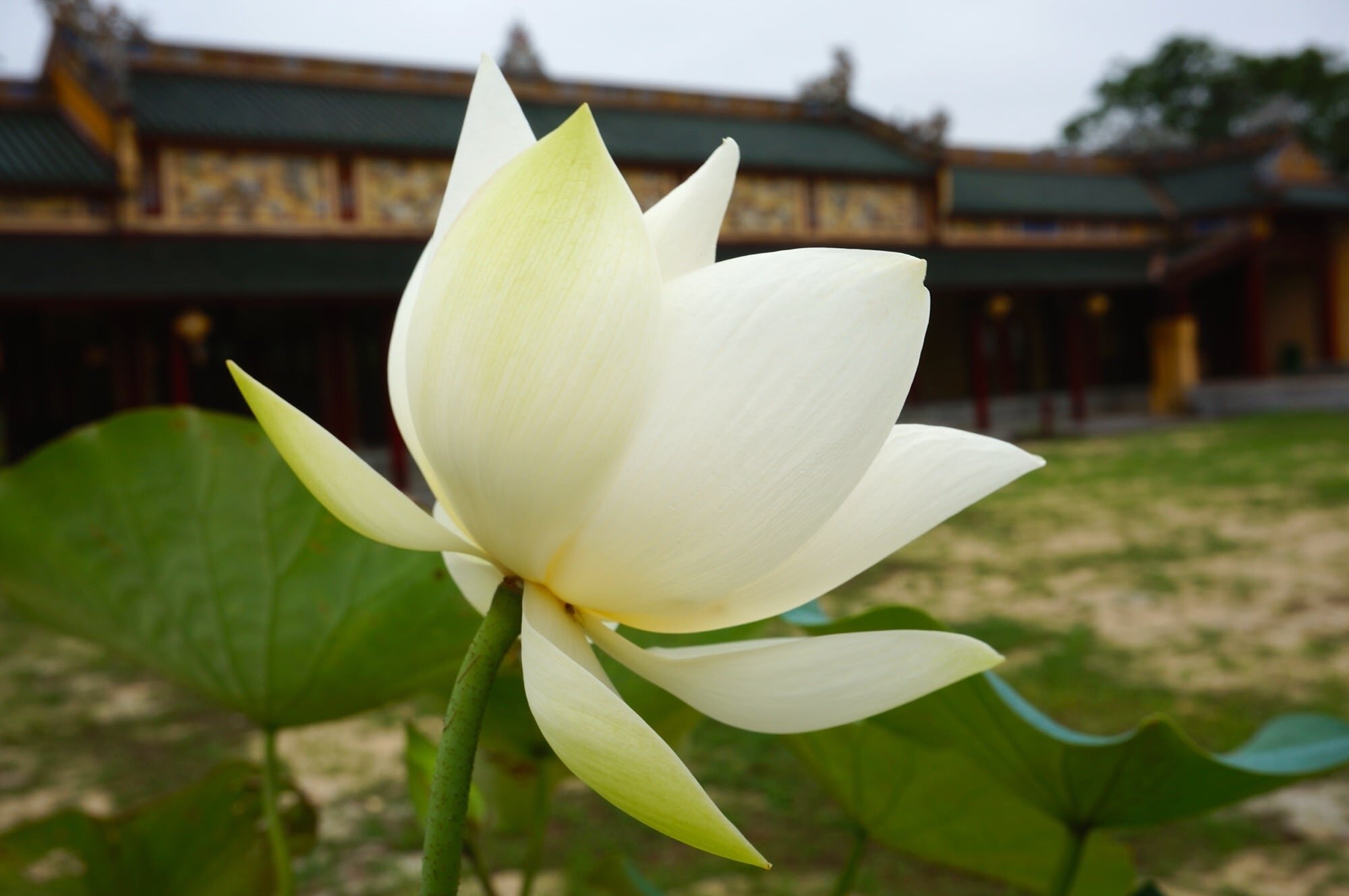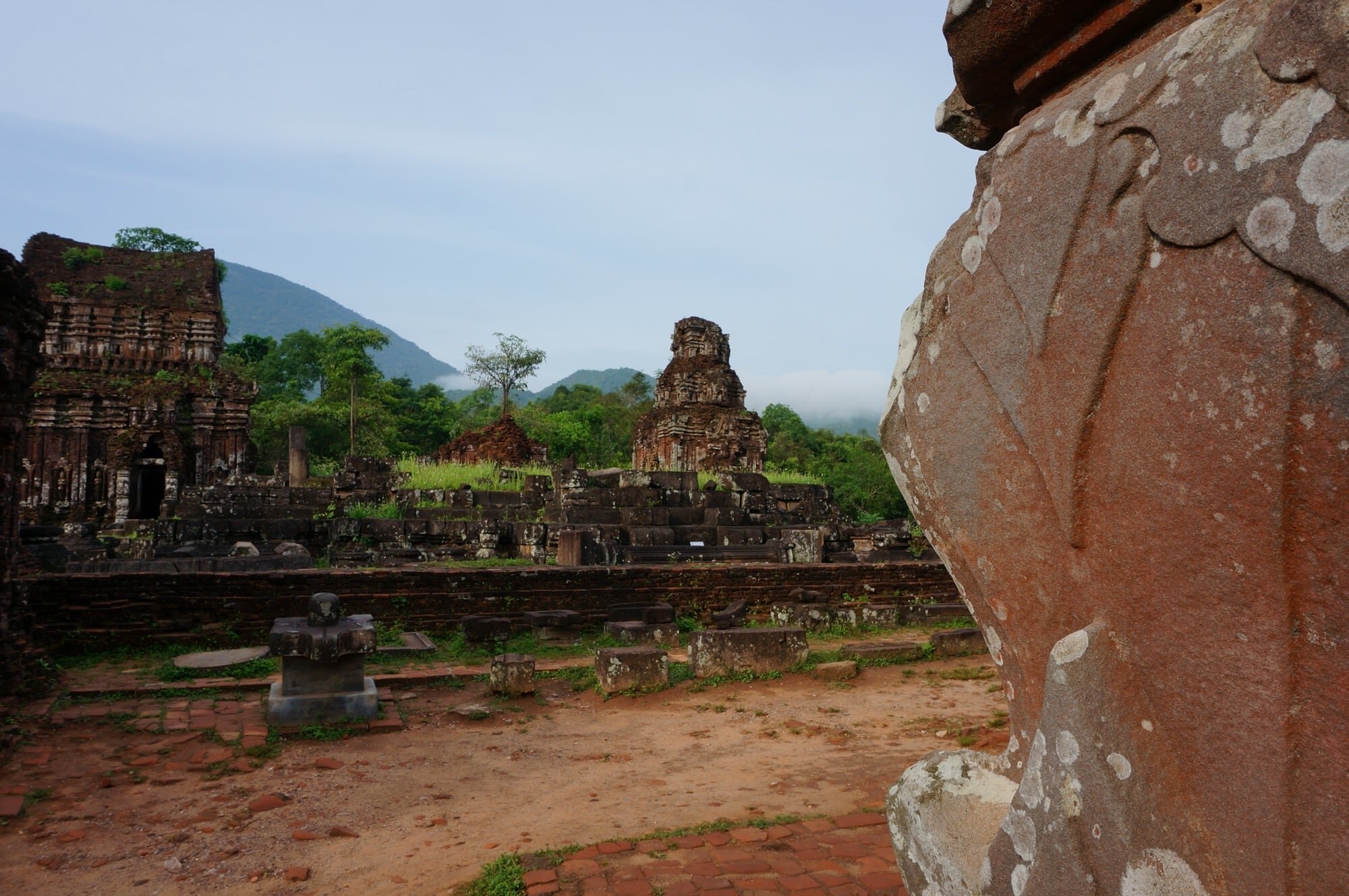Last updated August 2, 2025
This is my guide to living in Copenhagen. After seven years here as a foreigner, I often get asked for tips, so I’ve put them together for visitors. The guide is always changing and I’ll keep updating it with new discoveries. It focuses mainly on Vesterbro, where I live, and shares my personal favourites.
🥨 Bakeries
Copenhagen is famous for its legendary baking, so you can’t leave without trying some of the city’s treats. Don’t forget to sample both sweet and savoury options.
Hart Bageri - Hart is popping up everywhere, but absolutely one of the best places for pastries and the typical Danish breakfast, boller med ost (bread roll with cheese). Maybe we’re now reaching peak Hart. Having said that, the baking is still good.
Juno bakery - you’ll line up, but it’s worth it for the cardamom buns. The pistachio is croissant is the real star of the show though.
Andersen & Maillard have three stores - in Nørrebro, the City Centre and one in Nordhavn. Highly recommended for their square croissants.
Brød - a cute neighbourhood bakery in Enghave Plads. I love their almond croissant and cardamom bun.
Bonus souvenir pick - pick up a loaf of rugbrød from Lagkagehuset at the airport on your way home. It’ll keep well for a week.
🥪 Lunch / brunch
If you need sustenance other than baked goods, here are some options.
Torvehallerne - a covered market near Nørreport station. It contains a plethora of snack and lunch spots. My pick is Hav a fishmonger where you can build your own delicious fish salad platter. It’s not cheap, but it is delicious.
Admiralgade 26’s in the city centre serves a Japanese inspired brunch on the weekends. Book ahead. It’s simply spectacular.
Cadence - a solid brunch spot in Carlsberg Byen.
Mad & Kaffe - a solid choice for a hungover brunch in Vesterbro.
Palæ Bar - central but not on the tourist trail. Palæ Bar serves a truly unique smørrebrød (open sandwiches) experience. You walk into their kitchen and serve yourself. The smørrebrød is authentic, inexpensive and the service is warm.
Helge’s Ost - a really good deli serving excellent sandwiches on Værnedamsvej a cute side street linking Frederiksberg and Vesterbro.
Harlo & Meyer - a new iteration of the Meyers bakery and deli. Now also a new Nordic eatery, but still remains a bakery with pastries which you can take away.
Juno’s boller med ost
Smørrebrød at Palæ Bar
🦐 Dinner
There are so many recommendations online, and most mid-scale Copenhagen restaurants offer a solid 5-7 tasting menu in some approximation of New Nordic. Anyway, these are everywhere, so I’ll focus on some of the more unusual picks:
Old School Danish - If you want an old-school Danish experience, check out Restaurant Kronborg, 1733 (bizarrely Copenhagen’s only gay restaurant), or Restaurant Schønnemann. Make sure to try the sild (herring), flæskesteg (roast pork) is recommended and it’s bad luck to say no to some schnapps! Note, Schønnemann is only open for lunch and always booked up. If this is the case, try Restaurant Kronborg.
Fancy pick - reservation required - Kin Kin is the only Michelin-starred Thai restaurant outside of Thailand. One of the best places I’ve ever eaten.
Italian - Osteria 16 is in my view the absolute best Italian in Copenhagen. It combines the typical Copenhagen tasting menu concept with perfectly executed, slightly rustic Italian fare. Indulge in the tasting menu, you won’t be disappointed. They have three restaurants all with different menus, but the original on Haderslevgade is the best.
Local’s experience in Vesterbro - grab a cheap (but delicious) pizza from Itzi Pitzi Pizza and a couple of to-go drinks from Kihoskh’s extensive selection and enjoy your dinner in the park running down the middle of Sønder Boulevard.
Sushi - Yes, Sticks and Sushi is a chain, but it’s consistently excellent. Go with friends, have cocktails and try one of their sharing menus.
Burgers - the best burger spots in town are Gasoline Grill (multiple locations, started out in a gas station) and Tommy’s Burger Joint (Icelandic burger place in Kødbyen).
Budget dinner pick - Danes love to feel a little fancy. They also like to spend wisely. Restaurant Bouillon aces this brief. It’s a French bistro serving classics quickly and consistently well - or at least well enough for the price.
French Bistro - If you don’t mind spending a little more, I recommend Grimal, my absolute favourite bistro. They also serve a decent scotch egg. Not sure how this item made it onto the menu, but I’m so happy it did.
Kaktus Towers in Vesterbro
Amagertorv
🍺 Bars & nightlife
There are a million bars in Copenhagen - but here are a few loosely themed picks.
An evening in Vesterbro
Riga in Vesterbro has the absolute best vibe if the sun is out. I recommend their custom Pilsner or Spritz on tap.
Fermentoren also in Vesterbro has an almost unbeatable selection of beers and a slightly grungy vibe. The bar is candle lit - and the reason for this is the owner had decision paralysis about what lighting to choose, so just stuck with candles.
Other beer picks in Vesterbro are Warpigs Brewpub (also serving authentic BBQ). Åben a decent brewery with an industrial vibe. Mesteren & Lærlingen an energetic student bar with a great vibe.
Food at Warpigs
Bodegas
Bodegas, or brown bars are small smokey bars untouched by the polished aesthetic spreading through much of the city. Stepping into one feels like stepping decades. In these places I recommend ordering beer by the bottle (aka flaske)
Kanal bodega - one of the few bodegas where most of the drinking happens outside by the canal
Eiffel Bar - allegedly originally opened by a French immigrant in the 50s. This place has a quirky vibe and hasn’t changed much since it opened
Bo-Bi Bar - possibly my favourite bodega - they sell boiled eggs. And taking photos is banned.
Cafe Intime - gay, or at least gay friendly bodega. A really cosy spot with retro maximalist decor. You’ll feel like you’re back in the 1920s.
🏳️🌈 Gay Copenhagen
Copenhagen has a great selection of gay bars. Here are some of my favourites. If you’re having a bigger night out, I’d suggest visiting them in the order they’re listed below and if you’re in the mood at the end of the night finishing in Nevermind.
Oscar Bar & Café - the best place to start any night out and my favourite gay venue. Good food - I recommend the chicken Caesar salad. Wonderful, welcoming staff. Happy hour before 9 p.m. Lovely outdoor terrace in the summer.
Centralhjørnet - allegedly the world’s oldest gay bar. Still smokey. Great vibes and always featuring over-the-top seasonal decor.
Centre Stage - a relatively new bar. Solid gin and tonics, friendly staff. Classic music, photos of gay icons on the walls. Karaoke on Tuesdays. Drag on the weekends at 2 a.m.
Jailhouse - jail-themed basement bar. Recently non-smoking and all the better for it.
☀️ Summer sun spots
There’s genuinely no place like Copenhagen when the sun is out. Because it’s such a rare phenomenon, everyone is in a great mood and people will drop everything to relax in the sun. If you’re lucky enough to be in Copenhagen when it’s sunny these are my top experiences.
Any sunny harbour spot. It’s legal to drink on the street in Copenhagen, so grab some drinks and snacks and chill out at a harbour spot. This is a quintessential local experience. Grab a cold 6 pack of Tuborg Grøn from any supermarket and sit on the harbour watching people swim. I’d recommend doing this in Islands Brygge (great for evening sun), Kalvebod Brygge, Ophelia Plads or Krøyers Plads.
Sonder Boulevard in Vesterbro is a great place to chill out. It’s a boulevard with a grassy park running down the middle surrounded by lots of local bars and food spots.
Oscar Bar & Cafe - my favourite gay cafe has a wonderful terrace on Regnbuepladsen (rainbow square).
Rosforth & Rosforth - a wine reseller based under a Knippelsbro bridge sells wine by the glass or bottle. It’s the perfect place to sip wine and watch the harbour
Kayak Bar - On the opposite side of Knippelsbor is Kayak Bar - a half floating bar with great spots in the sun, kayak rental and seafood.
Reffen (Refshaleøen) - perfect for combining with a visit to La Banchina. At Refshaleøen you’ll find Reffen “the largest street food market in the Nordic region” Thing lots of street food vendors in containers by the water in an old industrial area. The food might be a little overpriced for what you get, but it’s a wonderful vibe in the summer. While you’re here check out Mikkeller Baghaven has the best evening vibes as the sun sets.
La Banchina - right next to Reffen, La Banchina is beyond idyllic. It’s one of the best places to go in the summer to sunbathe, swim, have a drink and have some fish from the charcoal grill. Just bear in mind this spot has been discovered so it’s likely to be packed.
La Banchina entrance
Mikkeller Baghaven
Kalvebod Brygge
Islands Brygge
Tourist tips
🚣♂️ Explore by boat. Rent a boat from Friendships or Go boat to have a self-guided tour of Copenhagen’s waterways. If you want a cheaper option, the touristy canal tours are surprisingly good.
🚲 Explore by bike - If you can, experience Copenhagen by bike. Make sure to stick to the right hand side of bike paths to avoid crashing with overtaking locals. To rent a bike, the Donkey Republic app is a good option.
🖼️ Museums - The Danish Design Museum is worth a visit, as is Louisiana a world-class museum of modern art on the coast north of Copenhagen. The Thorvaldsens Museum is a gem hidden in plain sight right next to parliament.
🗼Views - Other than the ubiquitous Rundetarn, visit The Christiansborg's Tower for an expansive (and free) view of Copenhagen’s skyline. Alternatively head to Copenhill (aka Amagerbakke) for a free view of Copenhagen from the roof of a power station moonlighting as a dry ski slope.
Nyhavnen
Danish Design
Perfect for a little window shopping (in the city centre, Mon-Sat)
Hay House - furniture brand’s flagship store
Normann Copenhagen - furniture brand’s flagship store
Illums Bolighus - a design department store
Paustian - a high end furniture store in an old bank
Studio Arhoj - unique playful Danish ceramics perfect for gifts or souvenirs
Distortion
Copenhagen Festival of Light
Copenhagen calendar
My favourite events not to miss in Copenhagen:
February - Copenhagen Light Festival - art installations and creative lighting illuminate the city’s winter nights.
May - Copenhagen Distortion - street parties and electronic music across different neighborhoods for several days.
June - 3 Days of Design - Exhibitions and events showcasing Danish and international design.
June/July - Roskilde Festival - Denmarks biggest music festival is a thirty minute train ride from Copenhagen.
July - Copenhagen Jazz Festival - a ten-day jazz festival featuring concerts and performances throughout the city.
August - Copenhagen Pride - Scandinavia’s largest Pride event with parades, performances, and a wild street party.
October - Culture Night (Kulturnatten) - annual night-time event where museums, galleries, and historical buildings open late across the city.

